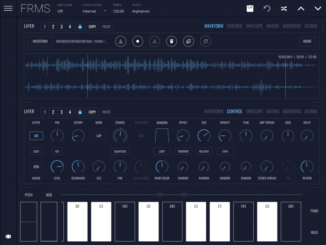Happy Birthday Animoog, Moog’s innovative iOS Synthesizer powered by the Anisotropic synth engine turns 10, Synth Anatomy looks back
As a media publisher, I am constantly trying to scour the web for the latest news. Whether hardware, plugins, or iOS, it’s all about news. Products that have been on the market for a long time leave the focus. No wonder considering the number of news items per week, even per day.
Last month, more precisely on October 11th, an app quietly celebrated its tenth birthday. Animoog, from Moog Music, launched on October 11, 2011, for a ridiculous price of $1. It was Moog’s first Synthesizer app also one that was professional in terms of both sound and concept. At a time when iOS making music was still in its infancy, without AUv3 support, etc. It’s time to get the app back into focus.
Moog Animoog
Animoog is based on the newly developed anisotropic synth engine. It uses wavetables as sound sources that can be integrated into a kind of vector synthesis. The highlight is the orbit system that you can launch with every note your play. It’s like a space full of wavetables where an orbit system drives through these and produces the respective sound. The new hardware Vector Synthesizer follows a similar system, but deeper and without wavetables.
Driving through the sound sources works in two ways. Either manually where you have the morphing process in your fingers. Here you have full control over how fast you go through these. Or you draw a syncable path that the orbit follows. Completely different sounds are possible here. At high speed, it even sounds a bit like ring/FM modulation. You can also set the X / Y values of the orbit how much it collects from source data. Then there is a classic ladder filter, bit-crusher, drive, delay, modulations (LFO, envelopes), looper, and a little 4-track recorder.
Animoog still fascinates me today. In 2021, 10 years after the initial release. Mainly because of its organic-sounding anisotropic synth engine but also of its expressivity available via the touch plates. These harmonize perfectly with the engine and enable expressive play that is known today from MPE controllers. Except that the app was only 10 years in advance to offer poly touch with its plates. And via in-app purchase, you can unlock the ability to use them with external instruments.
Custom Wavetables, New Presets
Animoog is a fascinating app that constantly inspires and challenges me. If you dive deeper into the engine, you also learn two tricks that you need to know. On the one hand, you can simply expand the number of sound sources. A desktop app called iFunBox (PC, Mac) gives you access to the app folder, where you can easily expand the sources.
New ones can be found, for example, on the fan website Animoog.org website. With these, you can expand significantly the sound spectrum in a very short time. For those who prefer to work with presets, there are also numerous new ones available as free downloads. You also need iFunBox for this. The associated sound sources must also be transferred to the respective folder, otherwise the presets will not work.
It all sounds super complicated, but it is super simple and absolutely worth the 15 minutes of work.
My Wishes For The Future
Animoog has been on the AppStore for 10 years. For several years, however, the development has stopped. According to the AppStore, the last update was in November 2019. The app works as always. No crashes or weird behaviors. This is a sign that the developer team have done an excellent job here.
Everything works now, how does it look in 1-2 years? I and many other users would be happy if Moog starts working on the Animoog again. New features, better file management through Apple Documents, optimizations for the current OS, etc. AUv3 will probably not be possible.
When asked about the topic, the current Moog software team said that the framework is too old to realize AUv3 support. Animoog 2 or Animoog Pro, yes why not. I think a lot of musicians would snatch it out of Moog’s hands. Even Suzanne Ciani, who uses the synth live on stage. In short, my greatest wish: updates, whether in the app or improved in the old one.
Moog Animoog is available now for iPad ($19.99 USD) and iPhone ($9.99 USD).
More information here: Apple AppStore






Be the first to comment